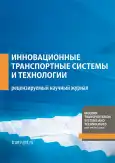The use of technical means for diagnosing traction engines rolling stock
- 作者: Ryzhova E.L.1, Osipov V.Y.2
-
隶属关系:
- Emperor Alexander I St. Petersburg State Transport University
- Saratov – Passenger Operational Locomotive Depot
- 期: 卷 10, 编号 4 (2024)
- 页面: 556-576
- 栏目: Original studies
- URL: https://journal-vniispk.ru/transj/article/view/277925
- DOI: https://doi.org/10.17816/transsyst635142
- ID: 277925
如何引用文章
全文:
详细
Aim. Demonstrate the practical significance of assessing the technical condition of traction electric locomotives during unsteady operating modes by analyzing the nature and causes of an emergency increase in the armature current of the NB–520V traction motor in traction mode. This study uses comparative analysis of trip file fragments from EP1 series electric locomotives at a locomotive depot.
Methods. A review was conducted on innovative methods for studying the unsteady operating modes of traction electric motors in locomotives. These methods help determine the causes of emergency armature current increases under various operating conditions. The emergency increase in the armature current was considered in the traction mode, for which the results of the fragments of the trip files were analyzed using a microprocessor-based traction motor diagnostic system installed on an EP1 electric locomotive.
Results. The proposed diagnostic methods allow for the detection of developing malfunctions early, preventing irreversible damage in traction motor operations. These methods also help plan the timing and volume of equipment repairs. The study identified the nature and causes of emergency armature current surges in the NB-520V motor during traction mode, which were linked to violations in standard operating modes of electric locomotives. A recommended procedure was developed for use in repair depots to identify and address unsteady operating modes of the traction electric motor.
Conclusion. Timely and correct diagnosis of traction motors can significantly reduce downtime during unplanned repairs, avoiding unnecessary costs for motor replacements. The developed algorithm enables efficient identification of the causes of armature current surges in traction mode, using diagnostic microprocessor systems on electric locomotives. These systems help develop preventative measures, reducing motor failures on the line and train delays. In addition to the recommended procedure for detecting traction engine malfunctions, the study highlights new opportunities for creating an integrated information and measurement system for monitoring and diagnostics, based on the current technical condition of locomotive equipment.
作者简介
Elena Ryzhova
Emperor Alexander I St. Petersburg State Transport University
编辑信件的主要联系方式.
Email: elena-astanovskaja@rambler.ru
ORCID iD: 0000-0001-7984-2558
SPIN 代码: 1880-3372
Candidate of Technical Sciences, Associate Professor
俄罗斯联邦, St. PetersburgVladislav Osipov
Saratov – Passenger Operational Locomotive Depot
Email: osipov.power@yandex.ru
ORCID iD: 0009-0009-4566-3274
SPIN 代码: 9408-0251
leading technologist
俄罗斯联邦, Saratov参考
- Durandin MG. Operation of traction electric motors in unsteady modes: lecture notes. Yekaterinburg: UrGUPS; 2016. (In Russ.) [cited: 23.09.2024]. Available from: https://h.twirpx.one/file/2435648/.pdf
- Kuzmich VD, Rudnev VS, Frenkel SYa. Theory of locomotive traction: textbook for universities of railway transport. Moscow: Marshrut; 2005. (In Russ.) [cited: 23.09.2024]. Available from: https://dntb-centr.ru/b/383?ysclid=lziaaio7od305187170.pdf
- Osipov SI, Osipov SS. The basics of train traction: тextbook for students of technical schools and colleges of railway transport. Moscow: UMK MPS of Russia, 2000. (In Russ.) [cited: 23.09.2024]. Available from: https://pomogala.ru/books_9_tyaga/osnovy_tyagi_poezdov_osipov.html.pdf
- Classification of diagnostic methods for traction electric motors. Lecture. 2024. (In Russ.) [cited: 23.09.2024]. Available from: https://lektsia.com/8x4871.html?ysclid=m1e1u4ssiq106233570
- Modern innovative methods of diagnosing traction electric motors. Lecture. 2024. (In Russ.) [cited: 23.09.2024]. Available from: https://lektsia.com/8x4872.html?ysclid=m1e1jfsjt0539678066
- Buinosov AP, Statsenko KA, Buinov AP, Statsenko KA. Technical diagnostics of electric rolling stock: an educational and methodological manual on the discipline «Technical diagnostics of electric rolling stock» for students of the specialty 190303 – Electric transport of railways. Federal Agency of Railway Transport, Ural State University ways of communication, Office: «Electric traction». Yekaterinburg: UrGUPS; 2008. (In Russ.) EDN: UCWJQA
- Bobrovnikov YaYu, Stetsyuk AE. Diagnostic complexes of electric rolling stock: textbook the manual. Khabarovsk: DVGUPS; 2012. (In Russ.) [cited: 23.09.2024]. Available from: https://studylib.ru/doc/6257526/diagnosticheskie-kompleksy-e-lektropodvizhnogo-sostava?ysclid=m1e2gmt4du528934562
- Melnikov VA. Improvement of methods for diagnosing 2TE116U diesel locomotives using data from on–board control systems. [dissertation] Moscow; 2023. (In Russ.) EDN: CFRVMO
- Yakushev AYa. Automated control systems for electric rolling stock: textbook the manual. Moscow: Educational and methodological center for education in railway transport; 2016. (In Russ.) [cited: 23.09.2024]. Available from: https:// djvu.online/file/R7Q3Zr8mpDuAy
- Semchenko VV. Operation and maintenance of electronic control systems of electric locomotives of alternating current. Krasnoyarsk: DCV of the Krasnoyarsk Railway; 2010:69–72. (In Russ.) [cited: 23.09.2024]. Available from: https://search.rsl.ru/ru/record/01004963946?ysclid=lziu4zxikq36401649
- Plaks AV, Shiryaev AV, Bragin AG. Limitation of current surges in a traction drive of an electric rolling stock with microprocessor control of a pulse voltage regulator: materials of temporary collectives. In: Electrification and development of railway transport in Russia. Traditions, modernity, prospects: Abstracts of the International Conference. Symposium Eltrans’2001. St. Petersburg: PGUPS; 2001. (In Russ.) [cited: 23.09.2024]. Available from: https://biblioserver.usurt.ru/cgi-bin/irbis64r_13/cgiirbis_64.exe?LNG=&Z21ID=&I21DBN=TFZHT&P21DBN=TFZHT&S21STN=1&S21REF=&S21FMT=fullwebr&C21COM=S&S21CNR=20&S21P01=0&S21P02=1&S21P03=A=&S21STR=Плакс,%20Алексей%20Владимирович
- Konkov AY. Fundamentals of technical diagnostics of locomotives: textbook the manual. Khabarovsk: DVGUPS; 2007. (In Russ.) [cited: 23.09.2024]. Available from: https://scb/uploaded/1_1361365445.pdf?ysclid=m1e2652qf9261594189
- Dorokhina ES. Monitoring of the thermal state of asynchronous traction electric motors [dissertation] Tomsk; 2015. (In Russ.) EDN: ZPSIOJ
- Volvich AG, Orlov YuA, Shcherbakov VG. Mathematical modeling of a multi-motor traction electric drive with independent excitation motors. Izvestiya vuzov. The North Caucasus region. Technical sciences. 2010;(2):38–42. (In Russ.) EDN: LHMHED
- Lapitskaya, GA. Innovative technologies of non-destructive testing and technical diagnostics of locomotives. In: Operational reliability of the locomotive fleet and increasing the efficiency of train traction: materials of the Third All-Russian Scientific and Technical Conference with international participation. Omsk, November 10–11, 2016. Omsk: Omsk State University of Railway Engineering, 2016. pp. 92–98. (In Russ.) EDN: XWXKYR













